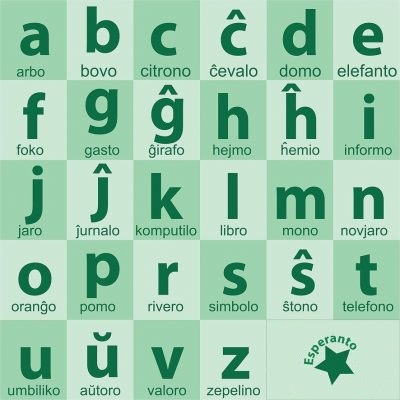
Esperanto is a constructed international auxiliary language, devised in the late 19th century, in order to create equality between different ethnic groups of the world, without a particular ethnic group having an advantage over another one (as opposed to English, which gives an advantage to English-speaking peoples only). Its grammar is simple, without any irregulars, which makes it a very easy language to learn, especially for speakers of European languages, on which it is based. Furthermore, this language is the most spoken language among the other constructed languages (Toki Pona, Ido and 300 other languages).
This website will expose you to the world of Esperanto. You can read here a brief history of the language, learn the alphabet, watch videos, and also find links to websites where you can learn the language, or just read some more information about this magical language.
A brief history
Esperanto was invented in 1887 by Dr. Eliezer Ludwig Lazarus Zamenhof (1859-1917), a Polish-Jewish ophthalmologist who was also a linguist, known by his pen name "Doktoro Esperanto". He originally called the language "La Internacia Lingvo" ("The International Language"), but it was soon known as Esperanto, which means "the hoping one".
Zamenhof was born in the Polish city of Białystok, which was then home to a multi-ethnic mixture of Poles, Russians, Jews, Lithuanians and Germans. He believed that much of the distrust and misunderstanding between the different ethnic groups was a result of language differences, so he decided to create an international language that could serve as a Lingua Franca and could help break down the language barriers.
Most Esperanto roots are based on Latin, although some of its vocabulary is taken from modern Romance languages (such as Spanish, French, Italian
and more...) as well as from English, German, Polish and Russian. The roots can be combined with affixes to create new words, for example: lerni = to learn,
lernejo = school, lernanto = student, lernejestro = principal, etc. in addition, the affixes can also stand alone: ejo = place,
estro = leader / head, etc.
The grammar has many influences from Slavic languages, although it is very simplified in comparison to them..
Esperanto is currently the most widely used international auxiliary language among the other auxiliary languages. The Universal Esperanto Association - La Universala Esperanto-Asocio (UEA) - has members in 120 countries, and there are national Esperanto associations in 70 countries. The most prominent countries in which Esperanto is spoken are Japan, China, France, Germany, Italy, Poland, USA, Brazil, Belgium and the United Kingdom. The number of Esperanto speakers is not known for certain, but the UEA estimates that there are about 2 million speakers worldwide.
Alphabet
Esperanto has 28 letters: 23 consonants and 5 vowels. Its alphabet is based on the Latin alphabet, without the letters q, w, x, and y (which are only used when writing unassimilated terms or proper names), and it includes 6 letters with diacritics: ĉ, ĝ, ĥ, ĵ, ŝ, ŭ. Each letter has its unique sound, which makes the process of reading and writing simple and easy.
The following image presents the Esperanto Alphabet :

Links
The following list contains links to websites with some more information about Esperanto and also some websites where you can learn the language.

- Esperanto phrasebook from Wikitravel
- Universal Esperanto Association page from Wikipedia
- Esperanto course on Duolingo - completely free!
- Esperanto in 12 Days - The Fastest Course for the Basics
- Esperanto page on omniglot.com
- Lernu - A multilingual site for learning the international language Esperanto
- The story "The Little Prince" (By: Antoine de Saint-Exupery) in Esperanto
Contact
Nimrod Markovich
+972-58-635-3457
nimrod.markovich@gmail.com
